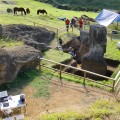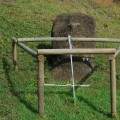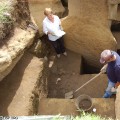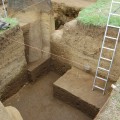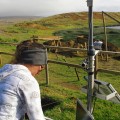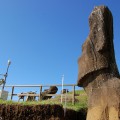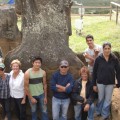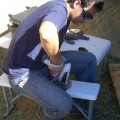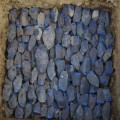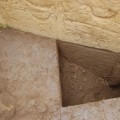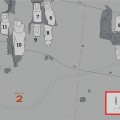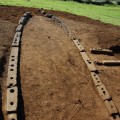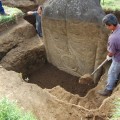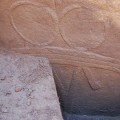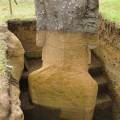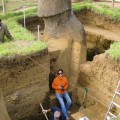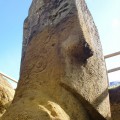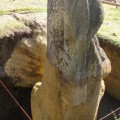Phase 1 Season 4
Easter Island Statue Project Conservation Initiative Preliminary Report
July-August 2011
Project Target Statues
The target statues from the inception of this project are RR-001-156 and RR-001-157, both of which are located within Quarry 2 of Rano Raraku. RR-001-158 is adjacent to Quarry 2 on the eastward side and was selected by the conservators as a study control. All of these designations are given on EISP Map Sheet 1 (Van Tilburg and Arévalo Pakarati 2009). Rano Raraku, the quarry in which fully 95% of the known 1,042 monolithic sculptural objects documented to date by this project were carved, is a unit of the Corporación Nacional Forestal (CONAF; www.conaf.cl) and, as such, a World Heritage site.
Easter Island Statue Project
The Easter Island Statue Project (EISP) is a private research program and archive created by Jo Anne Van Tilburg, Principle Investigator and EISP founder and director, with Cristián Arévalo Pakarati, Rapa Nui artist and co-director of EISP. The profound and immediate need for conservation actions on the moai became apparent over the course of more than 20 years of subjective observation and field experience acquired by us during our island-wide archaeological survey, which was conducted in association with our Chilean and Rapa Nui colleagues.
The Easter Island Statue Project office is located at 225 Arizona Avenue, Studio 500, Santa Monica, CA, 90401. The EISP field office is located at the Mana Gallery, Petero Atamu s/n, Hanga Roa, Easter Island (Rapa Nui), Chile.
EISP and this AIA funded project are devoted to six discrete but intricately interwoven activities that are also AIA goals:
- excavation,
- conservation,
- data collection and management,
- preservation and stewardship advocacy
- community outreach,
- student opportunities and education
The excavation and conservation teams included in this project are made up almost exclusively of local members of the Rapa Nui community. To date, this project has
- created research and design opportunities for interested members of our field teams and the Rapa Nui community, as well as UCLA students and volunteers,
- supported the stewardship of the archaeological record by providing all field generated data to relevant or collaborating Chilean and Rapa Nui agencies,
- employed 40 Rapa Nui people from the ages of 15 to 75, including distinguished elders and budding scholars,
- sustained a modest portion of the local economy.
Preliminary Statement
This report is the fourth in an unpublished and selectively distributed series documenting the implementation of the first legally permitted excavations in Rano Raraku quarry since those conducted by Thor Heyerdahl and the Norwegian Archaeological Expedition to Easter Island, 1954-55. All previous reports were provided to the agencies above and, as such, are matters of public record. In addition, each one was filed on www.eisp.org at the end of each season and is widely available in that format to the interested public. Photographs and other data beyond that provided here are also available at www.eisp.org.
Each EISP report describes project participants, methods, goals and results and is a preliminary draft document. However, the report series as a whole contains our initial research proposal and gives the complete history and implementation context of the project (see below). All of the reports are archived by the Easter Island Statue Project (EISP) and copies are provided or available to our funders as well as to all relevant Chilean agencies. To date, Van Tilburg has presented the project and results at two AIA conferences and one UCLA event. Abstracts or details of these presentations are available on the web sites of these organizations.
Excavation
The excavations described here are integral to the conservation actions planned and undertaken by this project on statues RR-001-156 and RR-001-157. They have very specific research goals and are required in order to
- record previously unrecorded, unique petroglyphs,
- preserve the petroglyphs,
- document statue details,
- compare statue details and petroglyphs with existing records of other similar features throughout the island,
- compare the same details with BM-LON-001 in the British Museum
- establish previously unreported excavation levels, 1914,
- establish previously unknown photographic levels, 1935,
- establish previously unknown surface destruction, 1954,
- retrieve and document stone tools for study and storage.
Environmental Monitoring
The conceptualization, implementation, and evaluation of conservation actions are the responsibilities of our colleagues Christian Fischer and Moníca Bahamondez P. in consultation with EISP and its data. As previous reports indicate, these actions include ambient environmental monitoring and environmental data collection as well as highly specific statue condition monitoring. The latter activity is unique to this pilot project and integral to the excavation plan. Data collection is carried out with the assistance of Rapa Nui scientist Tahira Edmunds, whose bi-weekly site visits allow her to download and send data to UCLA for analysis. Her visits are also part of our site monitoring plan.
Conservation Treatment
Statue stone condition data collection prior to and after excavation and specific types of conservation treatments are inherent in our pilot plan and crucial to our ability to generalize such actions to other statues in the interior of Rano Raraku. It is important to note here that the initially planned two-stage treatment plan was amended as a result of unfortunate vandalism to the site and illegal removal of the equipment in April, 2010. That vandalism, and the underlying social processes contributing to it, were neither caused nor created by this project. As befits the pilot project framework, a full assessment and evaluation of conservation actions will take place at the end of the data analysis phase, which we anticipate to coincide with backfilling of RR-001-156 in 2012.
Reports for three previous conservation seasons successfully carried out to date were generated and have been given under separate cover by our collaborators Dr. Christian Fischer, the Cotsen Institute of Archaeology at UCLA and Monica Bahamondez P., Director, Centro Nacional de Conservación y Restauración (CNCR). These reports with edifying illustrations are also posted at www.eisp.org.
Excavation Data Collection and Management
DATASHARE is a significant component of the Easter Island Statue Project and of this AIA funded Conservation Initiative. DATASHARE grew out of the original archive generated by personal field work between 1982 and 1986 (Van Tilburg 1986). However, its on-line potential was only recognized as a direct consequence of our Rano Raraku mapping project (Van Tilburg and Arévalo Pakarati 2009), which generated a mass of new data from 2000 to 2005. Our map is thus the organizing strategy for our entire data collection. Copies of our unpublished but copyrighted map, along with two volumes of our original Rano Raraku data, were provided to all Chilean authorities and today usefully facilitate the management of Rano Raraku by CONAF. Other full paper copies of our Rano Raraku portion of DATASHARE are held by all of the Chilean and Rapa Nui agencies copied here (Van Tilburg and Arévalo Pakarati 2009). The full on-line availability of DATASHARE requires further fundraising activity and its final content and scope is obviously dependent upon funding.
Excavation Collections Summary
DATASHARE contains, in addition to the records described above, a full and comprehensive record of the excavations we are conducting and the artifacts and eco-facts collected. Our series of linked reports includes an artifact database and an image database. Objects are collected in two ways: either within bags or as discrete objects. To date, two objects have been or are now being transferred to the local Museo Antropológico P. Sebastián Englert. These are a basalt stone with an incised curvilinear design (vaka; RR-001-157-478) and 800 g of concentrated red pigment (kie’a; RR-001-156-653; see below). Our identification system is sorted by the following traceable markers:
- unit designation (the statue numbers as they appear on our EISP map;
- squares(as they appear on our grid diagrams
- levels within squares (recorded as cm)
- 30 materials and object type categories
To date our collections include
- 1,588 artifacts collected
- 534 artifacts collected during Excavation Season IV
- 656 bags collected
- 204 bags collected during Excavation Season IV
- two objects transferred to the local museum for curation
Preliminary count of objects photographed, Excavation Season IV
- Toki (complete) 8
- Toki (fragments) 190
- Poro 6
- Unidentified tools 3
- Bone 78 bags
Unpublished AIA Project Reports, EISP Archive Cited www.eisp.org
Van Tilburg, J. 2009a. Easter Island Statue Project Conservation Initiative A Research Proposal to the Site Preservation Committee, the Archaeological Institute of America.
Van Tilburg, J. 2009b. Easter Island Statue Project Rano Raraku Research and Statue Conservation Initiative, 2009-2014. Permit Proposal to the Consejo de Monumentos Nacional, Santiago de Chile.
Van Tilburg, J. and C. Arévalo P. 2000. Computerized Image Catalog and Site Database, Easter Island Statue Project.
Van Tilburg, J. and C. Arévalo P. 2009. Reporte Datashare Rano Raraku. Report to the Consejo de Monumentos Nacional, Santiago de Chile and Corpración Nacional Forestal (CONAF), with copies distributed to five other Chilean and Rapa Nui agencies or authorities.
Van Tilburg, J. and A. Hom 2009. Preliminary Site Visits and DATASHARE Development Report, December.
Van Tilburg, J. 2010a. Interim Report to the Archaeological Institute of America, Site Preservation Committee, Season 1 April.
2010b Interim Report to the Archaeological Institute of America, Site Preservation Committee, Season II, November.
2011. Interim Report to the Archaeological Institute of America, Site Preservation Committee, Season III, February.
Fischer, C. 2011a. Environmental Monitoring and Conservation Mission. Report 1 to the Easter Island Statue Project, March.
2011b Conservation Mission and Environmental Monitoring. Report 2 to the Easter Island Statue Project, May.
Excavation Season IV Preliminary Report
Goals
The goals for this field season are to
- finalize the stratigraphic drawings for RR-001-157
- complete photo documentation of RR-001-157
- backfill RR-001-157
- transfer the inventoried level bags collected for RR-001-157 to the EISP field office for cataloging
- transfer selected objects to the island museum for curation
- inventory the tools (toki) collected this field season and store them
- carry on with the excavation of RR-001-156
- create an observational record of conservation actions taken during the recent (May) Conservation Field Season
- transfer this season’s toki records to Rafael Paoa Rapu for continuation of his XRF study
- arrange for chemical and other analyses of selected objects
- continue site monitoring
- continue conservation data collection
- schedule Excavation Season V (October-November 2011)
Field Crew
Jo Anne Van Tilburg, Ph. D., EISP Director
Cristian Arévalo Pakarati, EISP co-Director
Baihere Tuki Haoa, Field Assistant
Patricio Madariaga Paoa, Excavator
Tarita Maitai Riroroko Rapu, Excavator
Melisanda Pakarati, Screener
Margarita Pakarati, Screener
Nicholas Fredes Hey, Student
Martin Hey González, Student
Atahanga Icka Pakarati, Student
Support Staff
Rosa Ika Paoa
Anastasia Ika Paoa
Research Staff, EISP
Kim Anh Hoang
Deidre Whitmore
DATASHARE Development, EISP
Alice Hom
Ewan Branda, cand Ph.D.
Daily Schedule
8:30 Meet and breakfast
9:30 Arrive Rano Raraku
10:00 Arrive site; first day photo
1:00 Coffee break
1:30 Resume excavations
4:00 Last day photo; depart site
4:30 Depart Rano Raraku
5:00 Supper
6:00 End of day
Season IV Field Work Narrative and Daily Events Log
Thursday July 7.
JVT arrives Rapa Nui via Tahiti. JVT met with Cristián Arévalo P. and Rosa Paoa Ika to deal with logistical plans for serving the crew a customary daily breakfast (coffee and bread) and also hot lunch (supper) at the end of each day. JVT and CAP met with students and others who wish to work on the field crew. JVT met with Sonia Haoa of the Consejo de Monumentos Nacional and Lili González.
Friday July 8
JVT and CAP met with Ninoska Cuadros Huke, director of the Rapa Nui unit of CONAF. JVT and CAP audit profile drawings for RR-001-157.
Saturday July 9
JVT met in the morning with Chris Stevenson. Rafael Paoa Rapu, who is working on the XRF sourcing of the basalt tools removed from our excavations, will be at Chris’s lab in the U.S. for one week in January. He has an opportunity, as well, to visit the EISP office and UCLA as a follow-up experience. Obsidian samples from the lowest, previously unexcavated levels of our RR-001-157 excavations, with permission, will be carried by Rafael to Chris’s lab for the benefit of his learning process and for potentially useful analysis. We have retrieved 509 tools (toki) during our Rano Raraku excavations to Season III, and Rafael has collected the XRF data on 179 of them. This large sample forms the nucleus of his lithics studies.
Site Visit
Niko Fredes Hey joins us and we pick up some of our field equipment at the Mana Gallery and purchase poles to take to Rano Raraku to erect a tent as insurance against rain. CAP and NiKo erect the tent while JVT documents the current status of the site.
Site Monitoring
CAP’s observations made and actions taken during weekly monitoring of the site between field seasons have been very useful. Guava is persistent and tiny plants that had sprung up in various areas have been removed throughout the time since Season III. The profiles are fully documented in our audited stratigraphic drawings, and after our final photo record is made we intend to close the excavation of RR-001-157 during this season. We plan for Monday’s first field day and schedule tasks, including the backfill of RR-001-157.
Site Condition: RR-001-157
Squares 16, 17, 18, and 19 were among the first excavated and are in good condition, but fragile. Some toki and flakes once present in the NE sidewall and shown in the profile drawings have weathered slightly out of the sidewall and we removed them and will add them to the object collection after they are properly registered. They will be stored with the toki in Square 30. A toki in the corner of Square 12 was photographed in more detail and will be removed while backfilling.
The current depth of Square 19 is 65 cm measured from the surface (originally, according to our notes, at 80 cm measured from the line). The first set of photos shows Square 16 at 60 cm deep. Square 8 is eroded from its original 50 cm width to about 45 cm. Square 12 is eroded from 50 cm to 47 cm width. This is negligible.
Photos were taken to document the colors of the back of RR-001-157 to compare them with those taken in February. There is essentially no change, except that the top of the head to the bottom of the ears seems to be darker since the application of the water repellent. The lichens on the back of the head are dying and some have changed color from white to gray and black. The next level of color is gray to the shoulders, then tan to the mid-point of the arm. The tan portion is quite dry.
Control statue RR-001-158 was photographed (Figure 3 above) and the damage inflicted on its face by vandals in April, 2010 is nearly invisible now. The fence is intact and monitoring equipment is in place. Final overviews of the site were taken once the tent was erected. Excavation tools and the portable table we use as an office are stored on site.
Sunday July 10
JVT works on the collections in the EISP Field Office (Mana Gallery) for most of the day. All of the collections made during the previous excavations for Seasons I, II, and III had already been washed, bagged and logged. A print-out of that log was included in the Season III report. Our next task is to generate museum accession numbers in the catalog and then to physically assign them to each bag. All collected materials are stored in their original bags and the bags are in individual, labeled plastic bins annotated by season. A major task for October-November field season is that each bag, once the museum number has been attached, will have to be photographed with its contents prior to moving it into museum storage. We are training two Rapa Nui field assistants this process, and their experience on the actual excavations will facilitate this lab work.
Monday July 11
RR-001-157 Square 4 100-200 cm
RR-001-157 Square 5 30-220 (stopped at 175 cm)
RR-001-156 Squares 10 and 13 Shovel Scrape
Bags Collected: 6
We (7 members of crew) arrived at Rano Raraku. Vai photographed the overall condition of the excavation site as well as the various squares and their sidewalls and the papa or bedrock in the west wall of the excavation, along with various petroglyph details. Nico began clearing RR-001-157 Squares 4 and 5. JVT with Tari clears Squares 10 and 13 extensions under the papa. Vai photographed details of the papa west wall. Our goal today is to excavate RR-001-157 Square 4 now at 30 cm deep on the south and 1 m deep on the north and to begin Square 5.
Tuesday July 12
RR-001-156 Square 11 170-220 cm
RR-001-156 Square 12 170-220 cm
Bags Collected: 20
A large number of tourists in big groups are in the interior today. It is very time consuming as they have a lot of questions for us. CAP and Nico begin digging Squares 12 and 13. During the afternoon JVT photographs previously mapped paenga (RR-001-179), taheta (RR-001-178) and umu pae (RR-001-177) features in the middle of the interior slope in order to amplify EISPMap Sheet 5 and Map Sheet 6 (Van Tilburg and Arévalo Pakarati 2009).
Wednesday July 13
RR-001-157 Square 4 170-230 cm
RR-001-156 Square 10 150-220 cm (half)
Bags Collected: 28
JVT begins excavating Square 10, 150-220 cm (see July 20 notes). Shovel scrape of the square revealed a few bone fragments (animal) and numerous pebbles. One large rock was removed from the NW corner of Square 10. It measures 25 x 30 x 30 and is of very porous light gray basalt and, with the others, is stored on site. We note that the wall of Square 13 extension is holding nicely after a recent light rain. Vai repeats many artifact photos of the previous day due to a camera focus problem now resolved. In Square 4 we find a large piece of metal fused with coral in proximity to the statue.
Notes on stratigraphy: NE wall to 220 cm
- organic black to dark brown surface layer with vegetation extends as a lens about 30 cm deep into the next layer;
- yellow-brown soil with lapilli;
- lapilli layer is shot through with a thin inserted layer of brown-gray soil. Large pieces of basalt are present and there are vertical cracks throughout;
- thin layer of gray, lumpy soil;
- wide uneven layer of brown-gray soil has organic yellow-green material including pebbles; large piece of broken basalt and cultural material throughout;
- layer of pebbles and organic material
- ozidized metal associated with the Williamson, Balfour Company at about the 170 cm level (see earlier notes)
- our historic level book shows the 1914 level very clearly and from it we have calculated the rate of deposition.
- the 470 m deposit around RR-001-157 indicates the placement of the statue in an upright position at least 500 years ago.
Condition Notes: Dorsal View RR-001-157
The top of the head is ash gray and relatively smooth in appearance. White lichens on the upper half of the back of the head are spotted with gray-black pin pricks and appear to be dead or dying. There is a meandering patch of yellow-brown and thin, hair line cracks overall on the surface of both statues. The back of the head has an overall honey brown color and the surface is very even in texture. The raised spine is very apparent. The lower portion of the right ear has an overall gray and smooth surface but, just above it, there is a patch of brown and gray that seems to be an extension of the stratigraphy of the back of the head. The petroglyphs on the right side are visible. In general, the right side is more pulverized on the surface than is the left. The surface is dry thanks to the water repellant.
The shoulders are smooth with diagonal bands running right to left on the smoothed surface. The petroglyphs on the upper back are cut into this layer. There is a nearly rounded patch on the right back at the shoulder that is deep and reveals a thick conglomerate surface into which petroglyphs there are cut. The cupules on the left shoulder are in the lower eroded stone layer. Sheer plates and cracks both horizontal and vertical are present, and the petroglyphs are clearly etched into the previously eroded surface. The two vertical patches made on the loose slabs of tuff at the back of the head contrast in color with the current surface but will weather. Interestingly, not a single visitor has asked about them.
The EISP image database contains full documentation of the back of the statue and its condition to certain excavated levels. Images are on file from the Mana Expedition to Easter Island, 1914-1915; the Carnegie Expedition 1916; private collectors, 1914; the Norwegian Archaeological Expedition, 1954-1955 and several others (Figures 11, 12).
Condition Notes: RR-001-156 Ventral View
Some traces of original surface are still visible in the right eye socket and under the left brow. The top of the head is a very consistent ash gray in color and the same color is present on the left side of the brow. The brow itself has alternate lines of deep lapilli and smooth conglomerate. Diagonal and nearly horizontal lines of erosion cross the damaged face, which is dark gray to black. White spots of lichens on the left ear and the side of the face are present, along with a few spots on the bridge of the nose. The previously buried surface of the statue is an overall honey-brown color. Pieces of exposed basalt spot the lip. By far the best preserved surface is on the right side of the face below the ear. The surface there is plane and the Makemake petroglyph on it is very visible. The surface of the ear lobe just above is pulverized with visible conglomerate. The EISP image database contains documentation of the ventral side of the statue in the form of photographs or drawings made in 1914-1915, 1916, 1934-1935, 1954-1955, 1960, 1981 and following.
Thursday July 14 RR-001-156 Square 9 220-320 cm
Bags Collected: 19
We begin excavation (CAP with Nico) in Square 9. Small fragments of toki are relatively common, but intact or interesting specimens are rare. It may be that most of the toki from both statues were simply returned by Routledge to RR-001-157, whether or not they were originally removed from there. Unidentified fish bones are collected and the apparent remains of an umu are visible as a lens of black and gray in the soil. CAP clears the soil from near the right arm of the statue in Square 9. The stone is very yellow in color.
Friday July 15
RR-001-156 Square 8 220-320 cm (not completed)
Bags Collected: 13
Rain and drizzling all day makes it possible to view the highly successful results of the water repellant applied to the statues in May. The statues’ stone surfaces are soaked repeatedly, the beads of water simply cascade off and, if there is any sun at all, the entire exposed surface is dry within 10 minutes.
In Square 8 we exposed a deeply etched horizontal line drawn across the back of the statue precisely at the level of the top of the square. A single, large piece of carbon was collected at 54 cm deep near the back of the statue on the NW corner of Square 9 and just below the horizontal line. The soil is dark brown and heavy, and is water soaked with fine small pebbles throughout. A mass of animal bone (sheep?) is encountered. In Square 12 we uncover a thin but relatively even and consistent line of pebbles at the bottom of this level. When the soil was at this level (before 1914) there was an umu made (probably by men who worked for the Company).
Saturday July 16
Rain all day. Field work canceled. JVT meets with C. Stevenson, T. Ladefogel and their students to give an informal overview of the excavation prior to their site visit planned for July 19. CAP continues audit of profiles for RR-001-157.
Sunday July 17
JVT and CAP finalize profile drawings for RR-001-157. An interesting series of events is encoded in the stratigraphy and the various intrusions of excavations, especially by the Mana Expedition, are evident in the profiles.
Monday July 18
RR-001-156 Square 7 Shovel Scrape (I bag surface)
RR-001-156 Square 10 Shovel Scrape (1 bag surface)
RR-001-156 Square 8 Completed
Bags Collected: 6
Nico begins Square 9, which is wet but not flooded. JVT cleans the side of the papa on the west wall. The day is sunny and windy. Some more animal bone (sheep) is recovered in Square 8. Small stone rubble is found at 320 cm, including toki fragments and a quantity of black, decomposed basalt. A lens of this material is visible in the photograph of the square at 320 cm. Some small, thin roots of guava are attached to the sidewall but not to the statue back.
At about 4:00 PM today, which is very windy, a fire was accidentally started by someone employed to cut the grass and shrubbery. Flames, whipped by the wind, were sometimes over 4 m high and the smoke was very thick. Some of our crew went to help fight the fire, but it was obviously too dangerous. At the request of CONAF P. Hito, who arrived right away to try and control the fire, CAP drove to Hanga Roa to inform CONAF.
Tuesday July 19
RR-001-156 Square 11 220-320 cm
RR-001-156 Square 12 220-320 cm
Bags Collected: 16
JVT and CAP review RR-001-155, the remnants of a hare paenga. This feature, and another on the other end of the quarry (RR-001-212) were used as our GPS control points (Van Tilburg and Arévalo Pakarati 2009). Three of the stones (paenga) in RR-001-155 were visible during our mapping project, and one of them was used (Stone 3) the exact location of the point (Figures 17, 18). Three more stones are visible and we clear further vegetation and overburden to expose roughly half of the foundation.
Notes on RR-001-155 (hare paenga and survey control point)
The hare paenga is placed perpendicular to the slope and as exposed is 370 cm long, 156 cm wide at mid-point and 117 wide at the narrowest point (measured at Stone 4). It consists of 17 stones with an entrance and a portion of the poro paved terrace (taupea). Other stones from this structure are down slope. The stones are numbered from southwest to northeast and were documented consecutively.
Stone 1 Gray brown smooth basalt; total length 102 cm; width at widest point 16.5 cm; exposed 5 cm above ground; six holes on upper surface varying from 4 to 10 cm in diameter and from 2.5 to 7 cm deep.
Stone 2 Gray, porous basalt; total length 86 cm; width at widest point 15 cm; exposed above ground 5.5 cm; 3 holes varying from 4.5 to 5 cm in diameter and all about 4 cm deep.
Stone 3 Smooth, light gray and blue-gray basalt; 125 cm long; 19.5 cm wide at the top and 27 cm wide at the bottom including the beveled edge; 14 cm exposed above ground. There are two very small and shallow cupules on one end, one of which is broken; three cupules on the top range from 5 to 7.5 cm in diameter and from 2 to 6 cm deep. This stone is the EISP survey control point.
Stone 4 Gray-white crystalline basalt; the stone is in two pieces (A and B). Both of these stones are included in the EISP survey control point photographs. Stone A is 52 cm long and beveled. It is very well-made of a pock-marked, gray basalt. The top of it is 12 cm at the widest part and the base is 20 cm wide. Two shallow holes are 3.5 and 2 cm deep, respectively. Stone B is also beveled and of the same basalt type. It has one hole on the bottom that is 3.5 cm deep and two deep holes on the top (7 and 7.5 cm deep, respectively). The stone is 54.5 cm long and 39 cm wide.
Stone 5 is broken and 45 cm long. It is 11 cm wide and has two small and shallow holes.
Stone 6 is badly burned and discolored gray-black o top and reddish brown on the the sides. It is 68 cm long, 10 cm wide and 19 cm above the current ground level. There are 2 holes on top, one of which is 7 cm deep and the other 4 cm deep.
Stone 7 is 34 cm long and 16 cm above the current ground level. There are three holes, and the middle one is connected through another cupule on the site to another next to it. There appears to be a wear mark from the insertion of rope on the SE edge of one hole.
Stone 8 This stone may be part of Stone 7. I tis 37.2 cm long and 10 cm wide with two shallow holes
Stone 9 This stone may be part of Stone 10. It is very squared off, rectangular in shape and has two large holes. Total length is 40 cm long and 18 cm wide. It is only 7 cm above the current ground level.
Stone 10 is 30 cm long and has one broken edge and two holes. It may be part of Stone 9.
Stone 11 is an incomplete fragment that may be part of Stone 10. It is 17 cm long and 6.5 cm wide with three holes, one on each end is broken.
Stone 12 is 43.5 cm long and 16 cm wide. It has no holes and is located in front of the entrance to the structure.
Stone 13 is 30 cm long and 19 cm wide, with only 1 hole.
Stone 14 is 46 cm long, 14 cm wide, and has 3 holes
Stone 15 is 37.5 cm long and has 3 holes of different sizes and depths.
Stone 16 is 26 cm long and 14 cm wide with one shallow hole
Stone 17 is 21 cm long and 16 cm wide (exposed) with one hole.
The hare paenga foundation was excavated to 60 cm deep at the top of the slope and was exposed at ground level at the bottom of the slope.
The doorway is formed of 3 paenga and is 99 cm long from the curb and 48 cm wide. The exposed length of the structure is 7.80 m with a conjectured length of at least 10 m. It is 171 cm wide at the mid-point (exclusive of the entrance).
A curved endstone was brought from down slope and inserted back in the foundation at what we believe to be the approximately correct original location. The curbstone is 64 cm long, 29 cm wide and 12 cm height. It is formed of porous basalt similar to others in the foundation and has 1 broken post hole.
The significance of this structure is its relationship to RR-001-003.
Wednesday July 20
RR-001-157 Square 5 180-220 cm
RR-001-157 Square 4 180-220 cm
Bags Collected: 6
CAP continues to clear the hare paenga. A photographic record is made to amplify the map and object record. Note: On the bags collected from Square 5 (July 11) the level was noted as 2m but digging stopped at 175 cm. Square 5 is brought down to the level of Square 4 to clean the dirt from the surface of RR-001-157. A large, apparently unworked basalt stone is present in the sidewall but not removed. We retrieve lithics as usual and scattered animal bone. We begin the second half of Square 10 (divided longitudinally on July 13) at 150-220 cm.
Thursday July 21
RR-001-157 Square 4 220-330 cm
RR-001-156 Square 6 220-270 cm
RR-001-156 Square 7 220-270 cm
Bags Collected: 15
Notes on Backfill RR-001-157:
Ata will help Pato as he begins backfill of RR-001-157. Their first task is to clean and remove the vegetation (primarily roots) from the backfill pile and to remove the small stones so that all of the latter can all be deposited in the same layer at the same time. A portion of the east side of the enclosure fence is removed to accommodate the backfill process. The plan is to move the clean dirt from the pile by wheel barrow, deposit it in Square 19, and then to shovel it into the hole bit by bit. While time consuming, this will certainly protect the statue. This work begins at 12:20. The dirt is completely clean of refuse and stones. After several meters are deposited Pato compacts the soil.
Simultaneously, Tari and Nico continue the excavation of Square 4 at 220-320 cm. Martine, Margarita, and Melisanda with JVT are screening. The rain yesterday evening left everything damp or wet and we go extremely slowly so as not to overlook anything. The floor of Square 4 is smoothed to make it even with Square 12 at 320 cm. CAP and JVT discuss the curve of the statue’s back and consider constructing a frame that will allow us to measure it more closely.
In Square 4 at 300 cm we encountered an extremely large concentration of heavily weathered basalt (decomoposed) and large pieces of carbon near the SW corner of the square. The NE corner of Square 14 is eroded and uneven. A lens of charcoal is also present there. We create a step in which the ladder can be placed and then divide Square 6 in half with the top step being at 220 cm and the second at 270 cm down to Square 9 at 320 cm. CAP begins Square 7 at 220-270 cm at 3:45. Carbon and some animal bone is retrieved.
Friday July 22
RR-001-156 Square 7 220-320 cm
RR-001-156 Square 10 150-220 (completed)
Bags Collected: 9
Rain off and on throughout the night has further compacted the backfill. Some rain appeared again at about 10:30 AM. The excavation is wet but not even close to being flooded. We begin in Square 7 at 220 cm exactly. In Square 4 at 220-320 we find a very unusual portion of what appears to be the jaw of either a lamprey or blow fish. Pato and Ata continue the backfill. We level Square 7 for photos. We bring buckets of water from the lake and wash everything in the field before collecting. One of the CONAF rangers volunteers to screen, which is very helpful on a day like this. Finally finish Square 10 (begun July 13) at 220 cm by removing 30 cm of soil to the west near the papa to even everything out and make the sidewall of 7 and 10 meet properly. Finished Square 7 at 220-320 cm and continued backfill.
Saturday July 23
RR-001-156 Square 10 220-320
RR-001-156 Square 13 120-175
Bags Collected: 16
Square 13 is measured at only 93 cm because one sidewall is slightly bowed. The 1 m measurement is accurate at the top of the square but slightly tilted inward. This is not a function of erosion or error, but during the original excavation Dario and we thought that the wall would be the tallest in the excavation and would need to be somewhat stronger or more stable. The area in question is thus 150 cm long across Squares 10 and 13 at the top. The extension under the papa was amplified on the drawing and new measurements were taken. Bone (animal) was found immediately we began Square 13. Our goal in Square 13 is to even the line that defines the edge of it with Square 10 before going under the papa via the mapped extension. Digging of the next level of Square 10 220-320 begins.
Simultaneously, backfill continues on RR-001-157 to the level of the “M” design on the statue’s back. Larger rocks, including cores and some with worked surfaces, which were earlier removed from the excavation and stored on site are now placed on the back dirt in the manner of a level pavement. Some small flakes and chips are included in this level.
JVT checks and records notes on the level of damage to the various statues that resulted by the accidental fire of a few days ago. It seems that about 10 statues, exclusive of worked features such as shaped blocks, quarry details, and papa may have suffered flame or smoke damage.
Informal Notes on Damage Due to Fire (July 18, 2011):
In 2002, the EISP mapping project was carried out after a major accidental grass fire. All of the vegetation and every single statue, quarry and feature we mapped was included in the burned area. The ash under foot was several centimeters thick. This fire was confined to a more limited area.
During the recent (2011) fires we note that the entire stone alignment (RR-001-197) was burned, as were the following: taheta 195; statue torso 198; moai 202 and all those above and to the east of this statue. Everything on EISP Map Sheets 9 to 13 and in EISP Quarry Sections 15 to 19 was in the fire zone.
Monday July 25
RR-001-156 Square 8 320-420 cm
RR-001-156 Square 9 320-420 cm
Bags Collected: 9
Observations on RR-001-156, Dorsal View
From below the deeply etched horizontal line (220cm) a single strip of what appears to be moisture registers as a dark, wide line running from the right arm of the statues in an arc across the back and through the two circles to meet with a nearly square patch that is similarly dark. That patch extends from the spine to the arm and downward to the soil level. The lower portions of the circle and the arched lines on which they sit are now visible at 320 cm.
Coral is recovered in some quantity close to the moai in Square 9 at 340 cm. A large quantity of large pieces of carbon with mixed coral fragments, bone, obsidian flakes, and lapilli is collected, as are two molars (human?). Fowl and fish bone collected as well. Photos are taken at this point to document the accomplishment of our excavation of RR-001-157 and a bottle with the names of everyone on the crew (all four seasons) is buried in the soil at the middle of the circle.
Tuesday July 26
Heavy rain makes field work impossible today. JVT working on field notes; CAP on the second profile for RR-001-157.
Wednesday July 27
RR-001-155 : Surface to 60 cm (hare paenga)
Bags Collected: 2
We complete work on the hare paenga (see above). We surface clear most of the squares, which are still wet but undamaged and begin excavation of the extensions under the papa of Squares 10 and 13. Some bone (presumed to be human) is removed and stored in a separate box with a form given to us by the local museum. Once cataloged, the materials will be stored in the local museum with others previously retrieved (see November field report). Bone is all removed by JVT and CAP by hand. The rest were retrieved by Vai and Melisanda using tweezers at the field office at the back of the quarry. Privacy is ensured by blocking tourist access to that entire area.
In Square 10 at 166 cm we find metal. On another note, Margarita tells us today that last night an “old woman” cousin of Alberto Hotus told her that the name of the hare paenga we excavated (see above) is Hare Kai nga Poki.
Thursday July 28
Square 4 sidewall
Squares 7 and 9 surface 220 cm
Square 10 extension 120 cm
Square 13 extension 120 cm
Bags Collected: 14
Because portions of the excavation were wet due to rain we concentrated on the extensions of the squares under the papa, as they were nearly completely dry. All of the bones in these areas, some of which are human and most of which are sheep, were removed by CAP by hand.
Friday July 29
Square 4 extension 220 cm
Squares 7 and 10 extensions 220 cm
Bags Collected: 13
Shovel scrape surface of Square 10. CAP works on Square 10 extension under the papa while Ata continues the backfill of RR-001-157. We begin to remove a portion of Square 7 under the papa. Some red pigment is noted throughout the square and at 200 cm exactly Cristián found a large, egg-shaped quantity of pure red and still very bright pigment concentrate (kie’a).
Saturday July 30
Square 13 extension 175 cm
Bags Collected: 4
We begin removing Square 13 extension at 125 cm measured from the turf on the south wall and 120 cm from the papa on the same wall. The backfill of RR-001-157 is complete to just below the line of discoloration previously recorded by Routledge (1919), the Carnegie Expedition (1916) and later by the Norwegian Archaeological Expedition (1955-56). All surface erosion and other anomalies observed by the conservation process are contained above this line. Note the drying out of the left side of the back of the statue after exposure is proceeding nicely.
August 1
Square 13 extension to 220 cm
Bags collected: 6
Carbon is collected from three discrete lens in Square 13 extensions: one on the surface of the square at 220 cm; a second one on the same level but removed from the first, and a third at 194 cm in the sidewall of the same square.
August 2
JVT, Vai and Margarita meet with Francisco Torrres H., Director of Museo Antropolólgico P. Sebastián Englert (the local museum) to deposit the kie’a found (see above) and to discuss the curation of this fragile material. Later JVT, CAP, and Vai meet again with the director to finalize a system to expedite the cataloging of the collection of RR-001-157. We will insert a museum catalog number into our existing computerized catalog of bags collected and then also write the same number on the individual bag. The time consuming aspect of the process is then to photograph each bag and its contents and add that to the linked photo record. We have, including this field season, entered a preliminary count of 479 bags collected. A detailed listing of those objects by material is given in the Season III report and will be provided as an addendum to this report as well. The final days on the island are devoted to completing field records, closing the site and storing collections.
 English
English  Español
Español 